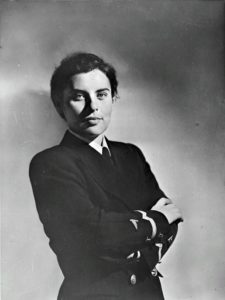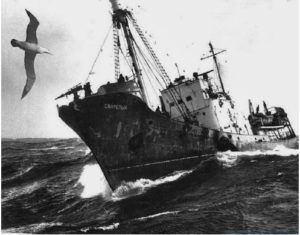- Author
- A.N. Other
- Subjects
- Biographies and personal histories, WWII operations, History - WW2
- Tags
-
- RAN Ships
- None noted.
- Publication
- December 2020 edition of the Naval Historical Review (all rights reserved)
By Alexandra Murtazaeva
Readers may remember Alexandra who while completing her studies in Australia helped out as a volunteer at the Boatshed. Now back at home in Moscow, she tells us of a young female who became a celebrity captain of ships in the physically demanding whaling industry, and was honoured as a Hero of the Soviet Union.
Despite the Soviet program aiming for female emancipation and equal rights for all in the starting years of the Soviet Union, and even generally following through with it during the 1920s, the onslaught of totalitarianism under Joseph Stalin’s rule put an end to it. Traditional roles were encouraged, especially when concerning naval and army service, despite the previous experience of many women fighting and being in charge of troops during the Russian Civil War. While the beginning of the Second World War encouraged some female volunteers to join the Red Army, it was mostly after 1942, which marked some catastrophic losses and lack of manpower, that the mass mobilisation of women was permitted.
The Soviet Navy wasn’t much different, and remained even more conservative in its wary approach to women aboard. Yet one of the exceptions to that practice is remembered in her hometown to this day, mentioned in several memoirs, and considered a hero. Her name is Valentina Orlikova, and she was the first female captain of a large refrigerator trawler in the world, the first female captain of a whale catcher, and a proud recipient of the Hero of Socialist Labour title, the highest Soviet degree of distinction for achievements in labour.
Valentina was less than five feet tall with brown hair and grey eyes; she had a graceful and slender figure and first came to prominence, at aged 27, in a Russian/American news clip promoting aid to the Soviet Union. Here we discover she was married to a merchant navy officer, who is also good at boxing; they met whilst undergoing training and had a two-year-old son.
Asked how does such a petite woman keep command over the men, she replied with a full list of her obligations aboard. By the end of the half hour long interview, having heard Orlikova’s swift and considered replies, in precise English, the interviewers didn’t need to ask the question again. In the same interview, Orlikova shared a personal account of her first sight of a Nazi submarine getting close to her vessel. Manoeuvring the ship and watching the torpedoapproach, she did not feel any fear, but an immense exertion. ‘I closed my eyes and counted to fifteen, and so it passed,’ she said. Professionalism and hard work — such are the qualities she was noted for by both her subordinates and superiors. Above all, she was just and yet kind. ‘We all nicknamed her our Mum’, writes Igor Kuramshin, who had served in the Murmansk Trawler Fleet and had worked under Orlikova’s command for six years.

Valentina was born on February 19, 1915, in the small provincial city of Sretensk, situated in a landlocked region nowhere near a large body of water. Her parents, a notary and a typist, moved to Vladivostok three years later which allowed the young Valentina to grow up near the sea. After studying in the Vladivostok technical college for four years, she had to move again, as her family travelled to Moscow. Yet riverside Moscow wasn’t a place to look for nautical schools, and Valentina chose Leningrad (present day Saint Petersburg) where she worked as a draughtswoman in the construction bureau of a large Baltic factory and studied in a working faculty of a ship construction institute. Due to a serious illness, she had to halt her studies after the first year, and worked on the construction of the Moscow-Volga water channel in the meantime. It is not known which part of construction she was involved in during her work on the channel, which is a pity: the channel, constructed between 1932 and 1937, connects Moscow to the Volga river and subsequently the Unified Deep Water System of European Russia. It is now infamous for being one of the grand Soviet construction sites of the 1930s that employed forced labour from the GULAG camps.
After taking a break from her studies, she abruptly moved to a navigation faculty at the Leningrad Institute of Water Transport Engineering. Not the easiest feat for a young woman! Head of University, Victor Bakaev, later to be Soviet Naval Minister, supported Valentina in her desire to study despite his personal doubts and complicated negotiations with the faculty. She successfully caught up with her classmates and passed all of her exams, later assigned to the training barquentine Vega with the rest of her group.
Valentina graduated in May of 1941 and was about to continue in her ship navigator practice aboard one of the vessels of the Baltic Sea Shipping Company. Unfortunately, the Second World War, also known as the Great Patriotic War in Russia and some other post-Soviet states, had other plans. Valentina had passed her exams for both marine engineering and small craft navigation in 1942, but her actual practice took place before the exams during the ill-fated Soviet evacuation of Tallinn in 1941. Known as ‘The Russian Dunkirk’, the evacuation of Soviet naval forces from the Estonian capital when surrounded by German forces had allowed for 165 ships, 28,000 passengers and 66,000 tons of equipment to escape. Yet the chaotic handling of the evacuation and German aerial bombardment in addition to heavily mined areas that the Soviet fleet was forced to pass through made the event one of the bloodiest naval battles in history.

Twenty one Soviet warships were lost, with over 12,000 casualties on the Soviet side (military and civilian). Valentina was aboard one of the last vessels to leave Tallinn, carrying over 7,000 wounded. When the vessel struck a mine and a dangerous leak threatened to sink the ship, she remained calm and worked among the crew; this succeeded in keeping the ship afloat until a destroyer took her in tow.
Afterwards Valentina was employed by the Northern Shipping Company as a navigator. Her first ship was on August 8th 1942, where she served as third mate. Initially the crew of the Dvina was wary of her presence, but had warmed up to her soon enough. Dvina was a motorship bound to the US with a cargo of manganese ore. The ship was not guarded as a British convoy supposed to protect Dvina was held up; having only five sniper rifles and two machine guns aboard, the captain had ordered the fabrication of several fake guns, displaying them on the ship’s sides to make up for the lack of military presence. Thankfully, Dvina’s voyage was undisturbed, and the ship’s crew even got to star in an American documentary about the Soviet merchant navy! On February 17, 1943, five members of the crew were invited to Hollywood to take part in a short film about their work. Valentina had no need for a translator and answered all of the questions insightfully and in detail, charming her American audience. When asked if she ever has any trouble with being a woman officer in charge of men, she smiled and said: ‘That is what I was trained for’, adding that there’s no difference between American and Soviet women, except they have the enemy closer, and thus all the more reason to fight for their home and children. The documentary, titled Valentina Orlikova in Merchant Marine: There’s Something About A Sailor,produced by the Army-Navy Screen Magazine No 06 (1943), is online1.
In 1947 Valentina transferred to the fishing industry and became captain of the whaler Storm. Nina Solovova, who served under Orlikova’s command on the ship, noted her firmness and even temper which made everyone on the quarterdeck forget her petite stature as soon as she opened her mouth. ‘She was a God’s gift of a captain’, Solovova remembers. Nicknamed ‘A Devil in a Skirt’ by the old sailors, she was loved by everyone on the ship. In 1953 Orlikova was granted command of a large freezer trawler, becoming the first female captain of such a ship in the world. She had been captain of Nikolai Ostrovsky and Novikov-Priboy for ten years, also working on the tanker Piryatin. As Igor Kuramshin reminisced about the six years under Orlikova’s command in the Murmansk fleet, he said she had once bought with her own money a TV for an able seaman in their crew, to congratulate him on his work. Her sincerity was a prominent trait. She had always strived for creativity and further innovation, seeking opportunities to increase freezer trawler production capacities, finding new fishing areas and suggesting new methods for handling the fishing process. The year of 1960 brought her the highest civilian decoration existing in the Soviet Union, the Order of Lenin, and the title of Hero of the Soviet Union, another highly prestigious Soviet award given for extraordinary feats in service to the Soviet state. After retiring Valentina moved to Moscow, where she lived until her death in 1991.
Note:
- Sharp eyed observers who run through the Army-Navy magazine news clip, which includes a New Guinea story, might notice the corvette HMAS Lithgow (J206) which served in these waters from 1942 to 1944.




